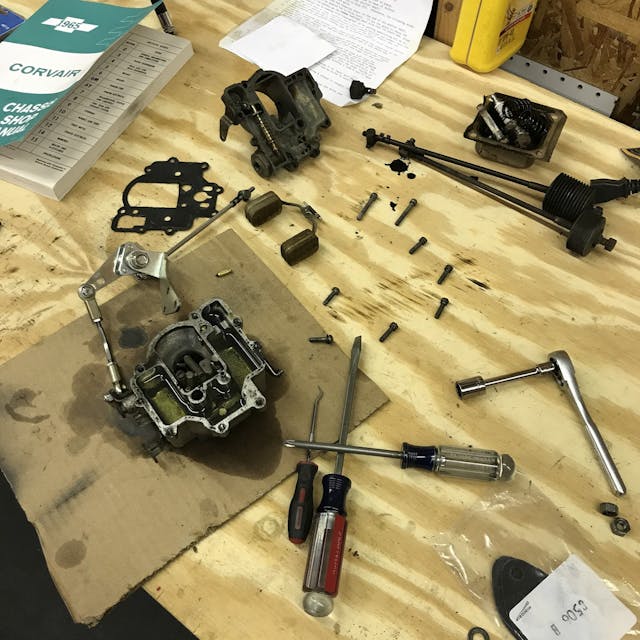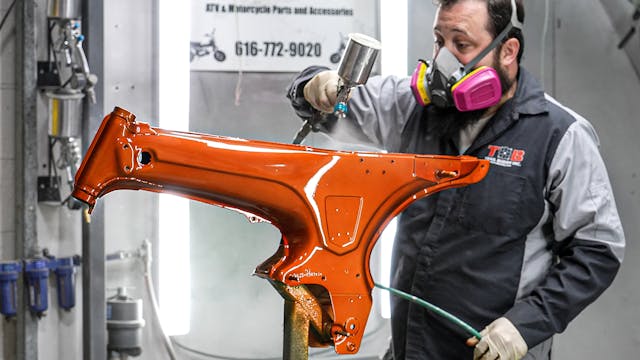The 6 most complicated restoration steps
A restoration in and of itself is complicated. Taking an object that is in less than desirable condition and returning it to its original condition—or as close to it as possible—requires tons of skill and understanding for simple objects. The restoration of a nice hardwood dining table could take weeks to do properly and that is a dozen pieces of wood. Scale that up to an automobile with thousands of precision parts that all have to interact flawlessly and, yeah, restorations are complicated.
Even if you elect to pay a pro there are steps in a restoration that just cause us to grimace at the thought of the task. Could boil down to the cost, time, or complexity of what needs to happen, or it could just be that for reasons unknown you just don’t want to. No matter, here are six of the most complicated restoration steps.
Carburetor rebuilding and tuning

It’s oddly polarizing to say this one, but the fact of the matter is proper care and feeding of carburetors takes an understanding of how they work. Take a minute to talk to a person who doesn’t like carbs and it usually boils down to how finicky the small passages are to keep clean and understanding how one seemingly small change affects the rest of the system. It nearly requires a degree in physics and chemistry to fully grasp just how precision-cut chunks of metal can accurately meter the amount of fuel going into the engine across a range of conditions. In short, it’s complicated.
Cylinder head assembly
The pieces are bigger than carburetors, but assembling a cylinder head requires the same attention to detail and even more specialty tools. Assembling a head that lasts requires setting proper spring pressures and sealing, which involves careful machining, parts selection, and also tidy and careful assembly. Yes, it is possible to just slap one together but could and should are two different things.
Engine machine work
We actually talked about this topic yesterday with a video from Jim’s Machine Shop, Inc on the process to complete just two of the machining steps required to bring a five-decade-old engine block back to service-ready status. It is literally tons of tools that possess the power to save an engine and also could mangle the operator or workpiece in horrific ways if anything but a skilled operator is at the controls. The precision required is humbling and the consequences of getting it wrong are significant.
Differential gear setup
Similar to the cylinder heads, differentials are something that most home mechanics don’t do often and that leads to it being a bit of a struggle when you do need the skill. Getting the gear spacing set perfectly on most differentials requires an understanding of precise shimming and the proper reading of the pattern in the paint that shows how the gears are aligned and meshing. Davin makes it look a little easy in this video and it still takes him a whole hour to have everything sorted out, prepped, and ready to work. It’s almost never that easy in the real world and, on top of it, gear oil is likely the most foul-smelling substance you’ll encounter when working on a car.
Paint application

Mixing ratios, application techniques, and expensive specific-use equipment all conspire to make a paint job difficult, and that is before you even talk about space or safety. The chemicals used in a paint job are a serious health concern and also can be a pain to dispose of after the fact. Even if you have all that knowledge and equipment there is still the process of preparing the object to be painted. Knowing which primer to use when, what the surface finish should be, how long to wait between coats, and how to get a truly flat surface that will have the desired finished look is hardly simple.
Automatic transmission rebuilding
In the hierarchy of things understood by most enthusiasts, the internals of an automatic transmission exists as witchcraft to many. Valve bodies with precise-size check balls and springs that need to be in the perfect place make carburetors appear to be a middle-school project if you are doing anything but disassembling and reassembling by the book. Even then it is easy to get confused or lost in the cryptic valve body that has a hundred passageways and none of them are clear and easy to see. Impossible? Hardly. Certainly complicated though.



Bottom line, most of this has a lot to do with your pocketbook and your willingness to tackle projects with a relentless commitment. Information is out there it always has been, be it a repair manual , You Tube or word of mouth. Something like machine work ( milling heads or boring an engine block ) has to be left to a machine shop unless your willing to spend thousands on equipment. You never will know if you can do it unless you try , and you won`t learn unless you attempt it.
Wiring!! How could you miss this step?! Most of us hate this part and spend an inordinate amount of time tracing what other people did to bodge the wiring over the last 30-80 years!!
I wouldn’t say “most of us.” I think wiring is a piece of cake. Harnesses are readily available for anything I’ve owned, and I can easily work from diagrams if needed. Now, I agree that working on wiring in something made in this century is a nightmare, but something from the 70s or earlier is no problem. You do have to take the color codes as “suggestions”, though because they fade with time. One trick is to hit the insulation with a bit of sandpaper to remove the outer layer and expose the original colors.
Good list of difficult things. Transmissions are something I don’t want to play with.
Absolute worst. Replacing the headlight bulb in a 2008 Toyota Yaris. It takes specially trained snakes. Toyota tool TOY57FU.
As someone that has experience in extensive automotive restoration, the only thing I have someone else do is upholstery. Everything else is relatively easy to me. But the one common thing that is the most difficult in any restoration is time. If you have a family and another occupation, finding the time to work on that garage project is difficult to say the least. That seems to be the main reason people outsource their automotive projects. We can all envision the finished results, but devoting the time (when you can find it) to work on it is the main stumbling block. And that is why I got paid to do it.
the absolute hardest part of any restoration is finishing it, I have seen many Restos start with good intentions, take a look at barn finds web site, many of those cars were blown apart with restoration in mind and then forgotten about, don’t start a project unless you’re ready to spend thousands of hours and dollars to complete it!
My Spit hard rear frame issues. Best quote was $400 So I bought a Lincoln Mig 120 volt welder. 2 1/2 days lying on my back, cardboard templates, lots of grinding. Looks and works probably better than original. Painting is not easy but not hard. Just get a compressor and do it. Way, way better than a spray can. then get an airbrush
Amen, you got it right
Number one, is or should be, staying focused.
Number two, is knowing and recognizing your limitations.
I have a formula which should be studied BEFORE any restoration begins. It is in 3 parts. In no particular order. If any 1 (ONE) step is omitted–do not begin the Restoration Project. 1. Time. 2. Money. 3. Space. This is the MOST CRITICAL part of any Restoration Project.
I got a different idea – Finishing the car. Once you get it running and on the road, it’s hard to wrap up all the little stuff
I had a machine shop mess up my cylinder heads decades ago. A non-BOSS, Ford Cleveland heads have pedestal-type valve rocker setup. I wanted screw-in studs installed, which needed to have the silly pedestal area machined flat to accept the studs. Well they milled them exactly flat, parallel to the block mating surface. Well, the Cleveland heads have compound angles for the valve train. None are parallel to the block deck surface. After some grumbling on their part, they told me to pick up another set at the local junkyard. It was actually a better head with closed chamber, but it had a small crack at one of the valve seats. I had an insert installed and it’s still holding up after 40 years.
Best solution for rust repair on a restoration is to pay more for a rust free car, it will save you a ton of money in the long run, as well the end result just looks so much better. It doesn’t matter to me how rare a car might be, I can’t stand looking at pitted lower control arms, rear axle tubes, frame rails , replaced floor pans, torque boxes etc. on the undercarriage of a car. Yes you can spend the extra time and money to fill in all the pits, but it makes you wonder how good was the rest of the car in the first place. When I go to look at a “restored” car I spend at least 10-15 minutes on a floor mat with a real good flash light, If I don’t like what I see under the car, the rest does not matter. That is why I have started to collect really good, lower mileage unrestored, rust free “real” survivor cars, you can actually pay as much or more than for a restored one, but what you see is what you get, you can’t fake it or hide it. They are actually more fun to take to a car show.
You can do anything you set your mind to do, sometimes you have to do it a couple times till you get it right but now you know for next time. I do all my own work except for machine work and that’s getting a lot harder to find a shop that you can trust. I painted my 69 Porsche 3 times before I was satisfied. I had lots of hours but only about $350 in material and a spray gun that I have used for several other projects plus about $15000 to buy more cars. So why would I spend $15000-18000 for a paint job? No wonder there’s so many trailer queens. If I spent that for a paint job I would be afraid to drive it too. I drive all mine and enjoy them, even let my grandsons drive them and the oldest just turned 16. If something happens I know I can fix it.
You need lots of garage space, which I am lacking with too many projects .. wife does not like car parts inside the home.
Do everything myself other than the final coat of paint and tire and wheel balancing ,if I had a bigger shop would love to have a nice paint section.